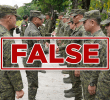DAVAO CITY – Indigenous peoples now temporarily settled in a church-owned compound here ask well-meaning groups to help them protect the area which they say is similar to an “ilihan.”
The IPs evacuation center is an empty lot inside the Haran House compound of the United Church of Christ in the Philippines in Davao City last March amidst alleged Army abuses.
“An ilihan or pangilihan is like an Army detachment which we go to in case of attacks or disasters. Haran might not be in the mountains, but it is an ilihan,” said Datu Benito Bay-ao.
Bay-ao is a traditional leader of Salugpungan Ta Ta’nu Igkanugon (let us unite to defend our ancestral land), an organization established by a group of Manobos in Talaingod, Davao del Norte.
An estimated 700 individuals from the territories of Salugpungan, Karadyawan from Kapalong, Davao del Norte and Kasalo from Bukidnon sought refuge in Haran.
“An ilihan has many characteristics, depending on the area and situation,” said Bay-ao.
He said one concept is “a fenced, fortified area during a pangayaw (traditional warfare) where only allies and recognized mediators can enter.”
“But with the Army’s guns and other lethal weapons, such structure do not stand a chance, perhaps it can repel attacks from spears and arrows,” he said.
Bay-ao said their actual and recent experience of an ilihan was in 2004 and 2009 allegedly when Army forces tried to intimidate them into joining paramilitary groups.
He said the name of the group was the BDS (Barangay Defence System) which they refuse to join so they left their homes instead.
“The place was the area’s highest point but there was no fence, not even trees. The section of the mountain before the highest point was close to bald, but the other section was thick with trees where we can hide,” he said.
Bay-ao said the mountain is “an overlooking area where a watcher can warn others of a coming enemy by simply creating sounds”.
Bay-ao said another concept of an ilihan is “ sometimes the location of a panubaran (prayer hut), which is usually built on top of a mountain.”
Datu Min Malibato said their concept of an ilihan in Kapalong is the same as in Talaingod, but theirs have “more fortification”.
“Some place large bamboo trunks around the walls of their houses. The bamboo is then filled with water which they believe can even stop bullets,” said Malibato.
“Eventually, the residents still leave their houses as it is not an assurance of safety. We do not risk it,” he said.
Salugpungan Datu Tunguig Mansimuy-at said that in Talaingod, their natural ilihan extends to the Pantaron range of mountains.
“There, it is hard for outsiders to chase us as one can easily get lost among the thick forest and vegetation,” he said.
Mansimuy-at said that is why they react very strongly at reports that “mining interests target Pantaron.”
“Pantaron is our source of food and our refuge,” he said
Myfel Paluga, an anthropologist from the University of the Philippines Mindanao said historian Zeus Salazar has recorded the ilihan.
“Salazar claims all Austronesian (peoples from some countries in Asia, Oceania and Africa which speak the
Austronesian language) have an ilihan concept,” said Paluga.
Paluga studied with the Manobos in Talaingod for several years.
Meanwhile, Bay-ao scored a statement from Second District North Cotabato Congresswoman Nancy Catamco that “the bakwet (evacuation) is not in the customs of lumads”.
“The ilihan is our natural evacuation where we can utilize available resources from our communities to survive. The military has driven us to bakwet into Pantaron several times, if she doesn’t know it yet. We walked several days and have no food,” he said.
Catamco became controversial recently when she attempted to “rescue” the lumads out of Haran.
The lumads resisted but the police broke through the gates hurting almost 20 people from both sides.
The crises ended with the intervention of Davao City Vice-Mayor Paolo Duterte.
Catamco is head of the House of Representatives’ committee on indigenous peoples.
Meanwhile, Datu Min said “the Haran is an ilihan outside of the mountains.”
Bay-ao said “while the Haran as an ilihan might be more of a political than a cultural concept, in here we control the gates while good people help us in our struggle.”
Bay-ao said they can only return to their homes once “the Army and the Alamara (paramilitary) do not recruit us by force and leave our communities in peace.”
“We hope many will help us without any conditions,” he said.(davaotoday.com)










